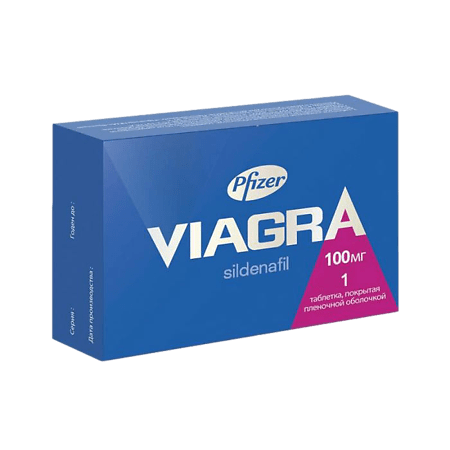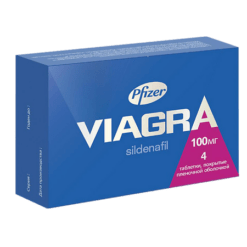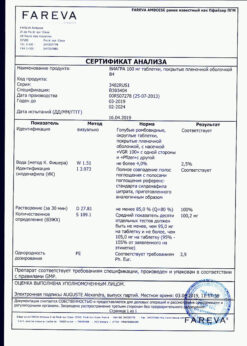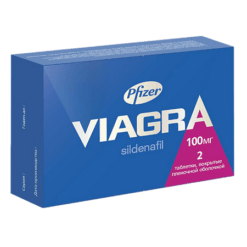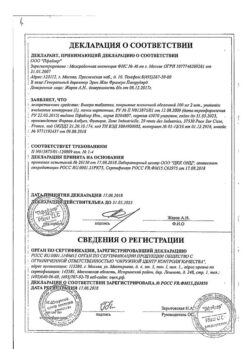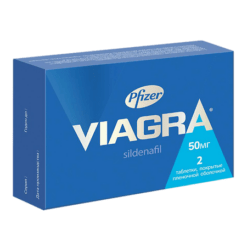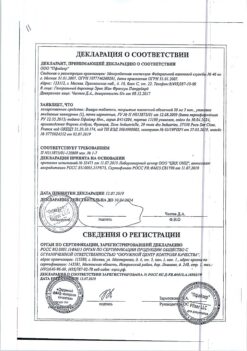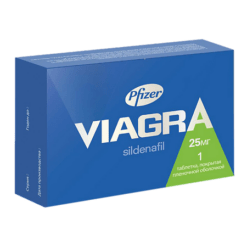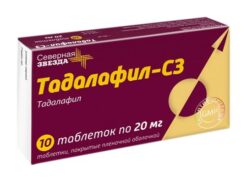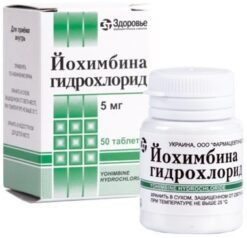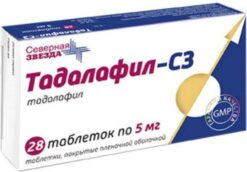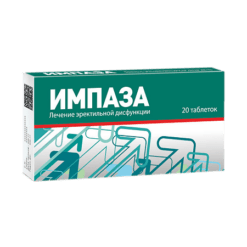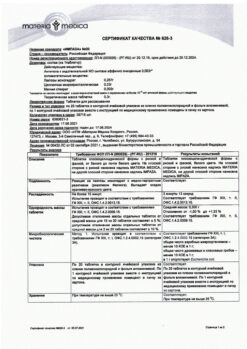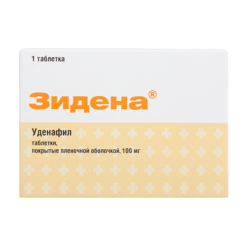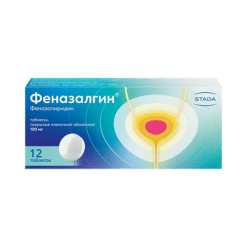No products in the cart.
Viagra, 100 mg
€30.97 €25.81
Description
Pharmacokinetics
The pharmacokinetics of sildenafil are dose-dependent when taken orally in the recommended dose range. Absorption
After oral administration, sildenafil is rapidly absorbed from the gastrointestinal tract. Absolute bioavailability of sildenafil is on average about 41% (25-63%). Maximum plasma concentration of Stach when taken orally on an empty stomach is reached within 30-120 minutes (on average 60 minutes). When taken in combination with fatty foods the absorption rate is reduced; Cmax is reduced by 29% on average, and the time to reach maximum concentration (Ttah) is prolonged by 60 min.
Distribution
The volume of sildenafil distribution in equilibrium is on average 105 liters. Binding to plasma proteins of sildenafil and its main circulating N-demethyl metabolite is approximately 96% and is independent of the total drug concentration. Less than 0.0002% of the dose (188 ng on average) was detected in semen 90 min after sildenafil administration. Metabolism
Sildenafil is metabolized mainly in the liver under the action of microsomal cytochromeP450 isoenzymes: CYP3A4 (main pathway) and CYP2C9. The main circulating active metabolite formed as a result of N-demethylation of sildenafil undergoes further metabolism. The plasma concentration of the metabolite is about 40% of the sildenafil concentration. Excretion
The total clearance of sildenafil from the body is 41 l/hour, and the final elimination half-life is 3-5 hours. After oral administration sildenafil is excreted as metabolites mainly in the feces (about 80% of the dose) and to a lesser extent in the urine (about 13% of the dose). Elderly patients
In elderly patients (65 years and older) sildenafil clearance is decreased and free sildenafil plasma concentrations are about 40% higher than in younger patients (18-45 years). Renal failure In mild (creatinine clearance 50-80 ml/min) and moderate (creatinine clearance 30-49 ml/min) degree of renal failure ^ sildenafil pharmacokinetics after a single oral administration of 50 mg does not change. In severe renal insufficiency (creatinine clearance < 30 ml/min) sildenafil clearance is decreased, resulting in approximately twofold increase in the area under the pharmacokinetic curve (AUC) and Stah (88%).
Hepatic impairment In patients with cirrhosis (Child-Pugh A and B), sildenafil clearance is decreased, resulting in an 84% increase in AUC and 47% increase in Stach.
Pharmacodynamics
. The active ingredient of Viagra – sildenafil is a potent selective inhibitor of cycloguanosine monophosphate (cGMP) – specific phosphodiesterase type 5 (PDE5). Sildenafil has no direct relaxant effect on the isolated cavernous body. Sildenafil enhances the relaxing effect of nitric oxide (NO) by inhibiting FDEF5, which is responsible for the breakdown of cGMP in the cavernous body.
The result is relaxation of the smooth muscles and increased blood flow in the corpora cavernosa.
Indications
Indications
Treatment of erectile dysfunction, characterized by the inability to achieve or maintain a penile erection sufficient for satisfactory sexual intercourse.
Viagra is effective only in the presence of sexual stimulation.
Pharmacological effect
Pharmacological effect
Pharmacokinetics
The pharmacokinetics of sildenafil is dose-dependent when taken orally within the recommended dose range. Suction
After oral administration, sildenafil is rapidly absorbed from the gastrointestinal tract. The absolute bioavailability of sildenafil averages about 41% (25-63%). The maximum plasma concentration of Stax when taken orally on an empty stomach is achieved within 30-120 minutes (on average 60 minutes). When taken in combination with fatty wheat, the absorption rate is reduced; Cmax decreases by an average of 29%, and the time to reach maximum concentration (Tmax) is extended by 60 minutes.
Distribution
The volume of distribution of sildenafil at steady state averages 105 liters. The plasma protein binding of sildenafil and its main circulating N-demethyl metabolite is approximately 96% and is independent of the total drug concentration. 90 minutes after taking sildenafil, less than 0.0002% of the dose (average 188 ng) was detected in semen. Metabolism
Sildenafil is metabolized mainly in the liver under the influence of microsomal cytochrome P450 isoenzymes: CYP3A4 (main route) and CYP2C9. The main circulating active metabolite, resulting from N-demethylation of sildenafil, undergoes further metabolism. The concentration of the metabolite in the blood plasma is about 40% of the concentration of sildenafil. Removal
The total clearance of sildenafil from the body is 41 l/hour, and the terminal half-life is 3-5 hours. After oral administration, sildenafil is excreted in the form of metabolites mainly in feces (approximately 80% of the dose) and to a lesser extent in urine (approximately 13% of the dose). Elderly patients
In elderly patients (65 years and older), the clearance of sildenafil is reduced, and the concentration of free sildenafil in the blood plasma is approximately 40% higher than in young patients (18-45 years). Renal failure With mild (creatinine clearance 50-80 ml/min) and moderate (creatinine clearance 30-49 ml/min) degrees of renal failure, the pharmacokinetics of sildenafil after a single oral dose of 50 mg does not change. In severe renal failure (creatinine clearance <30 ml/min), the clearance of sildenafil is reduced, leading to an approximately twofold increase in the area under the pharmacokinetic curve (AUC) and Cmax (88%).
Liver failure In patients with liver cirrhosis (Child-Pugh A and B), the clearance of sildenafil is reduced, resulting in an increase in AUC by 84% and Cmax by 47%.
Pharmacodynamics
The active substance of Viagra, sildenafil, is a powerful selective inhibitor of cycloguanosine monophosphate (cGMP) – a specific phosphodiesterase type 5 (PDE5). Sildenafil does not have a direct relaxing effect on the isolated corpus cavernosum. Sildenafil enhances the relaxing effect of nitric oxide (NO) by inhibiting PDE5, which is responsible for the breakdown of cGMP in the corpus cavernosum.
As a result, smooth muscles relax and blood flow increases in the corpus cavernosum.
Special instructions
Special instructions
To diagnose erectile dysfunction, determine its possible causes and select adequate treatment, it is necessary to obtain a complete medical history and conduct a thorough physical examination.
Treatments for erectile dysfunction should be used with caution in patients with anatomical deformation of the penis (angulation, cavernous fibrosis, Peyronie’s disease), or in patients with risk factors for the development of priapism (sickle cell anemia, multiple myeloma, leukemia).
Medicines intended to treat erectile dysfunction should not be prescribed to men for whom sexual activity is undesirable.
Active ingredient
Active ingredient
Sildenafil
Composition
Composition
Active substance:
sildenafil (as sildenafil citrate) 100 mg;
excipients:
microcrystalline cellulose,
calcium hydrogen phosphate (anhydrous),
croscarmellose sodium,
magnesium stearate,
film coating Opadry blue and Opadry transparent.
Pregnancy
Pregnancy
Not intended for use in women.
Contraindications
Contraindications
– Hypersensitivity to any component of the drug.
– Use in patients receiving continuous or intermittent nitric oxide donors, organic nitrates or nitrites in any form.
– Age up to 18 years.
– Not intended for use in women.
With caution: anatomical deformation of the penis (including angulation, cavernous fibrosis or Peyronne’s disease), diseases predisposing to the development of priapism (such as sickle cell anemia, multiple myeloma, leukemia, thrombocythemia), diseases accompanied by bleeding, exacerbation of peptic ulcer disease, hereditary retinitis pigmentosa, heart failure, unstable angina, myocardial infarction, stroke or life-threatening arrhythmias in the last 6 months, arterial hypertension (BP > 170/100 mm Hg) or hypotension (BP < 90/50 mm Hg).
Side Effects
Side Effects
Adverse effects are usually transient and mild or moderate. The incidence of adverse events increases with increasing dose.
From the body as a whole: asthenia, pain, abdominal pain, back pain, infection, flu-like syndrome.
From the cardiovascular system: vasodilation (a side effect recorded in clinical studies).
From the digestive system: diarrhea, nausea.
From the musculoskeletal system: joint pain, muscle pain.
From the central nervous system and peripheral nervous system: dizziness (a side effect recorded in clinical studies), increased muscle tone, insomnia.
From the respiratory system: nasal congestion, pharyngitis, rhinitis (a side effect registered in clinical studies), sinusitis, respiratory tract infections, respiratory dysfunction.
Dermatological reactions: rash.
From the senses: changes in vision: mild and transient, mainly changes in the color of objects, as well as increased perception of light and blurred vision (a side effect recorded in clinical studies), conjunctivitis.
From the urinary system: urinary tract infections.
From the reproductive system: dysfunction of the prostate gland.
When using the drug in doses higher than recommended, side effects were similar to those noted above, but were usually more common.
Adverse events reported during post-marketing use are listed below.
From the cardiovascular system: arterial hypotension, fainting, tachycardia, palpitations.
From the digestive system: vomiting (a side effect recorded in clinical studies).
From the reproductive system: prolonged erection and/or priapism.
From the senses: pain in the eyes, redness of the eyes.
Other: allergic reactions.
Storage conditions
Storage conditions
In a dry place, at a temperature not exceeding 30 °C
Shelf life
Shelf life
5 years
Manufacturer
Manufacturer
Fareva Amboise, France
Additional information
| Shelf life | 5 years |
|---|---|
| Conditions of storage | In a dry place, at a temperature no higher than 30 °C |
| Manufacturer | Farève Amboise, France |
| Medication form | pills |
| Brand | Farève Amboise |
Other forms…
Related products
Buy Viagra, 100 mg with delivery to USA, UK, Europe and over 120 other countries.

